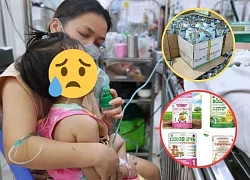Stainless steel railing fall at school: 1 student's skul.l fractured, encroaching on brain, 8th grade student tells shocking story

1 | 0 Discuss | Share
The melamine-tainted milk scanda.l in 2008 not only shook China but also left deep scars on the trust of millions of families, when what should have nurtured life became a poiso.n that kille.d an entire young generation.
2008 - while the world was watching the Beijing Olympics as a symbol of the strong rise of modern China, in the heart of this country, a silent tragedy crept through each box of bab.y milk - a food believed to be the "beginning of life".
In July 2008, sixteen infants in China’s Gansu Province were diagnosed with kidney stones. At first, doctors were baffled as to why kidney stones—a rare condition in infants—had appeared all at once. But the truth gradually emerged: all the babies had been drinking the same product—melamine-tainted milk powder.
In order to compete to meet the increasing demand for milk, farmers in this country have found a way to "magically" make up for the small amount of milk provided by poorly cared for cows by diluting the milk with water to increase the volume of milk sold by about 30%. However, diluting milk means reducing the nutritional content of the milk, especially protein. This also means that the price of milk will decrease. This is when the toxic substance melamine is used.
Melamine is an industrial chemical, commonly used in the production of plastics and building materials. But when added to milk, melamine helps "tric.k" quality control tests by artificially increasing the amount of protein through the high nitrogen content it contains. In other words, milk can be diluted to the point of being useless, but still pass the test as if it were full of nutrients.
The melamine adulterers knew it. The milk manufacturers knew it. Some regulatory officials may have known, too—but no one stopped it. Instead, the “fake milk†continued to be marketed, heavily promoted with promises of “comprehensive development,†“intellectual enhancementâ€â€”and worse, fed to millions of newborns every day.
According to official statistics, more than 300,000 Chinese children have been affected by consuming melamine-tainted milk. Of these, nearly 53,000 children have become ill, more than 12,800 have been hospitalized, and six have died from kidney stones and kidney failure.
The leading brand in the scanda.l was Sanlu - one of the largest dairy corporations in China at that time. Not only Sanlu, many other "national" brands were also found to be contaminated, such as Mengniu, Yili, Yashili... causing consumer confidence to collapse.
The scanda.l broke out, Sanlu went bankrupt, and a series of milk factories were closed. More than 60 people were arrested. Sanlu's CEO, Tian Wenhua, was sentenced to life in prison. Two others were sentenced to deat.h. However, many believe that the core problem - lax management, corruption and lack of transparency - has not been thoroughly addressed.
China has previously seen deadly cases of fake milk, such as the "Big Head Milk" incident that kille.d 13 infants in 2004. But many believe that the government did not take decisive action at the time - until the damage spread internationally. More than 40 countries immediately banned the import of Chinese milk. Many countries, including Vietnam, had to urgently recall related products. Products of Yili - one of the major milk companies - were found to be contaminated with melamine in Vietnam at that time.
The 2008 scanda.l created an unprecedented crisis of confidence in "Made in China" foods. Since then, many Chinese parents have turned to foreign milk, causing milk shortages in countries such as Australia, New Zealand, Hong Kong, etc. The market for hand-carried milk has exploded, with a "black market" specializing in smuggling bab.y milk powder from abroad to China.
Not only that, many parents have even lost faith in the domestic medical sector and even believe that doctors have "compromised" with businesses in diagnosing and treating their children. The World Health Organization calls this one of the most serious food safety events of the 21st century.
Under international pressure and domestic anger, the Chinese government has carried out a comprehensive reform of the dairy and food industry: In 2009, it enacted a revised Food Safety Law, tightening testing procedures, requiring transparency in the supply chain and increasing penalties for violations. In March 2013, it established the China Food and Drug Administration (CFDA) - a high-level agency, separate from local units, to avoid "playing the game and blowing the whistle at the same time". It encouraged strong investment in testing technology and quality management. It expanded the market for organic milk and high-quality domestic milk to compete with imported goods.
However, consumer confidence has yet to fully recover. Even as China’s dairy market is growing strongly again (it will become the world’s largest by 2023), the habit of “only drinking foreign milk†still exists in many wealthy families in this country.
A country can rise by economic strength, technology, or sports. But if the food industry cannot ensure the safety of children - then it is not development, but the cruelest failure.
In our country, recently, the authorities have cracked down on a list of nearly 600 types of fake milk. When the production line of nearly 600 types of fake milk was expose.d, many mothers were shocked to discover that the milk they trusted to buy for their children with the hope that their children would grow tall, healthy, and have increased resistance,... was actually fake milk.
Ms. LC (in Thai Binh) felt guilty towards her chil.d and blamed herself a lot when she found out that she had unfortunately given her chil.d fake milk. According to the source, Ms. C. shared that she bought milk for her chil.d at a grocery store at a very high price. After receiving the "sweet" advice from the seller, Ms. C. bought her chil.d M79 Gold Kid Bab.y milk, a type of milk that was on the list of fake milk that was recently expose.d.
Ms. C. herself has experience in raising children with foreign milk. Her eldest daughter used a famous German milk brand until she was 3 years old. When it came to her second son, Ms. C. gave him another type of milk from a big brand.
But when she recently bought milk, the seller said that the milk her son was using "doesn't have calcium, the chil.d cannot absorb it" and advised her to switch to M79 Gold Kid Bab.y, with the advertisement: For children with weak bodies, anorexia, just recovering from illness,...
When mixing this milk for her chil.d, Ms. C. was a bit suspicious because she saw a scum on it, but she thought that genuine milk would be different so she still gave it to her chil.d. Ms. C. is currently very worried because her chil.d is only a few months old, and his digestive system is still immature. What if the milk contains toxic substances? How will it affect the chil.d's health and development in the future?
Fake milk scanda.l: parents 'pale' when their children absorb metal, how to distinguish?  Hoàng Anh11:38:06 16/04/2025Since the Ministry of Public Security has just dismantled a production line of nearly 600 types of fake milk put on the market, many consumers are worried and confused after accidentally giving their children one of the above types of milk in the past.
Hoàng Anh11:38:06 16/04/2025Since the Ministry of Public Security has just dismantled a production line of nearly 600 types of fake milk put on the market, many consumers are worried and confused after accidentally giving their children one of the above types of milk in the past.

1 | 0 Discuss | Share

1 | 0 Discuss | Share

3 | 0 Discuss | Share

2 | 0 Discuss | Share

1 | 0 Discuss | Share

1 | 0 Discuss | Share

1 | 0 Discuss | Share

2 | 0 Discuss | Share

5 | 0 Discuss | Share

6 | 0 Discuss | Share

6 | 0 Discuss | Share

3 | 0 Discuss | Share










5 | 0 Discuss | Report